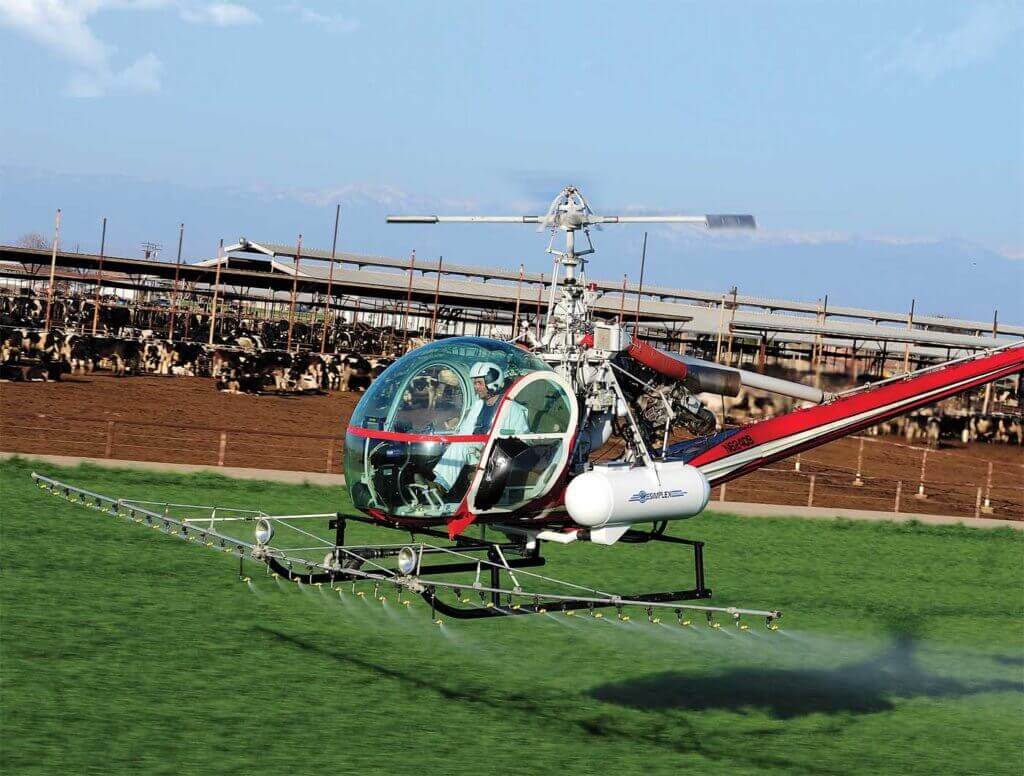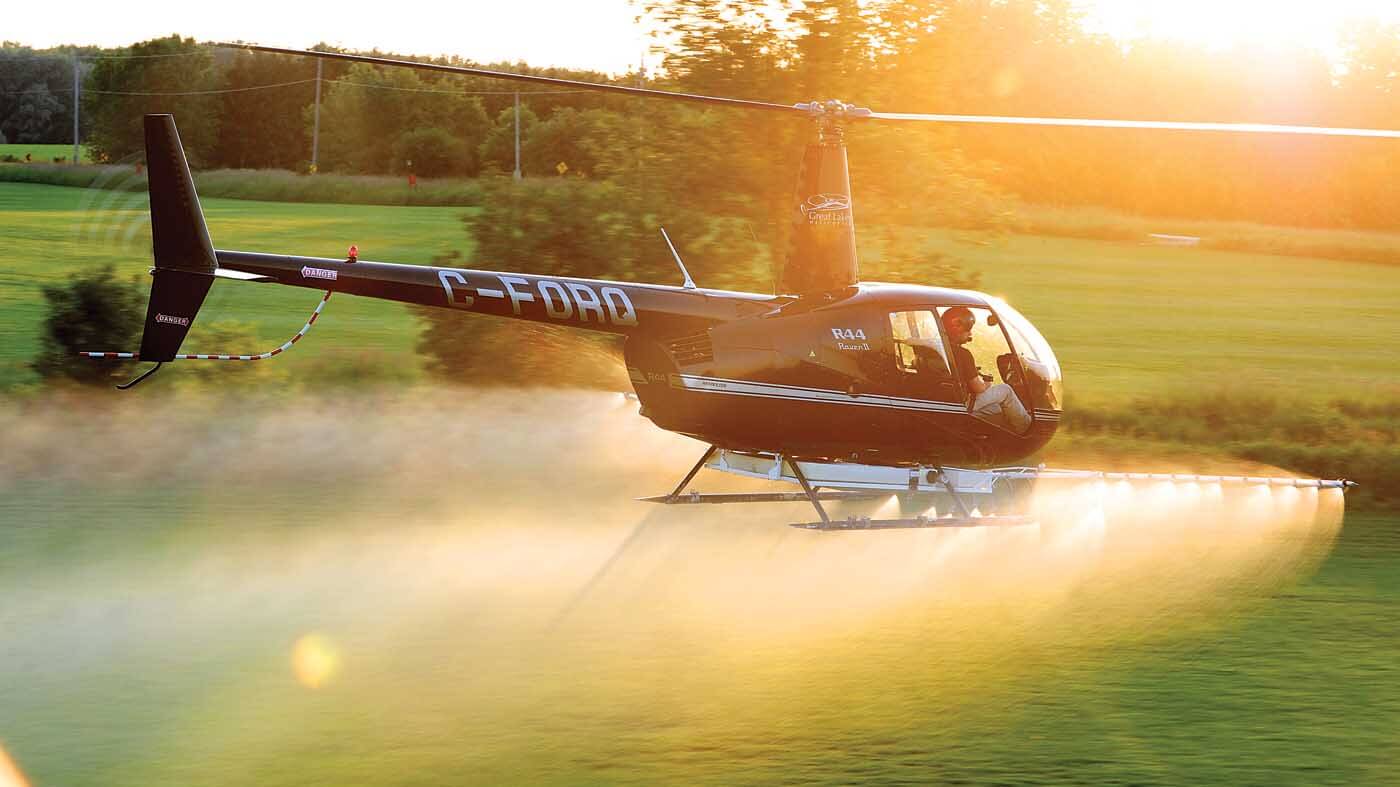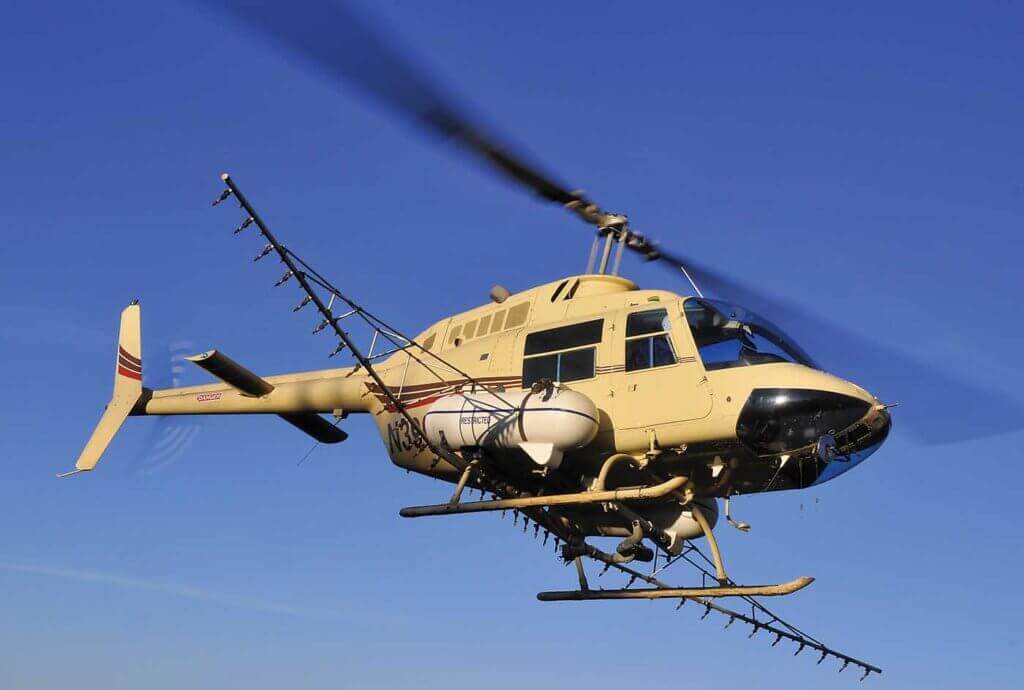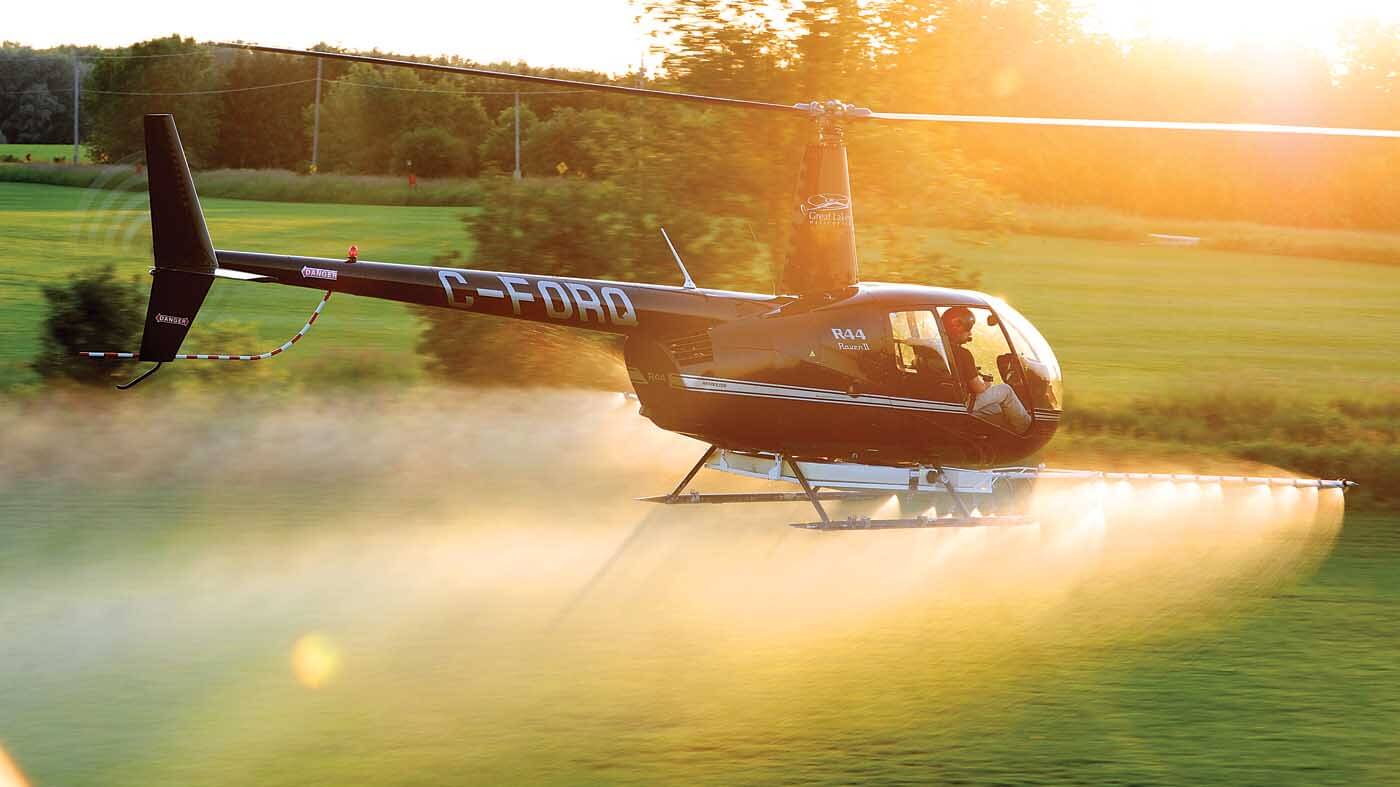Over the past three years, my articles have dealt mainly with safety concerns related to various weather conditions. But even when the weather isn’t threatening, it still plays a major role in many helicopter operations. Some operations can be disrupted or prevented by the weather, even though it’s still safe to fly, while others are completely dependent on the appearance of specific weather conditions.

Perhaps no sector has utilized the versatility of helicopters more than agriculture. From aerial spraying, to frost prevention, to the mustering of cattle — the list of potential applications goes on and on. And just about all of these jobs are weather dependent, with very specific requirements in terms of winds, temperature, and humidity. Weather conditions are crucial to get the job done.
Aerial application — spraying chemicals such as pesticides, herbicides, and fungicides from an aircraft — has been the mainstay of agricultural aviation for many years. For more precise application, a helicopter is generally preferable to a fixed-wing aircraft, with temperature and wind speed critical for a successful operation.
Most of the chemicals used have a specific temperature range for application, typically given on the container. Temperatures approaching freezing are problematic for water mix solutions, for obvious reasons. “The higher temperatures — above 85 F [29 C] — also work against you, with the chemical water mix evaporating before it hits the ground,” Tony Herby, chief pilot for Sky Aviation in Worland, Wyoming, told Vertical.
Plant processes can also be temperature dependent. “We normally don’t start spraying [herbicide] before the temp reaches 50 F [10 C], because the plant isn’t taking nutrients in through the leaves until the plant warms up,” explained John Smith, pilot, co-owner, and co-founder of J&R Flying Service in Alicia, Arkansas. “So, it would be hard to kill the plant if it wasn’t absorbing the chemical properly.”
At the other end of the scale, higher temperatures don’t just bring the danger of evaporation. According to David George, pilot and owner of M&D Aerial in Spearman, Texas, when the temperature exceeds 92 F (33 C), plants can “close up” — meaning they will not ingest the chemical.
Turning to wind speed, George said some was needed for best product coverage, but that operators need to be aware of the drift of the spray. Too much drift will take the product to where it can do damage to different crops — which becomes particularly problematic if those crops are on another farm. He said that most aerial applicators have insurance in case this happens, and that the limited availability and high cost of this insurance is a major incentive to prevent drift from happening.

“If [the wind is] less than three miles per hour, there is the chance the chemical could climb and drift for miles,” added Herby. “The more obvious upper limit of 10 mph or greater could blow the chemical ‘lines’ off target as well.”
The amount of predicted rainfall is also a concern, as too much could “wash off” the product. “Most chemicals need from one to four hours’ dry time before rainfall to make sure the plant has taken the chemical in,” said Smith.
High humidity can be just as problematic. “Too much moisture [in the air] can dilute the product, or cause ‘burns’ on the plants,” said Rick Throckmorton, director of operations for Aspen Helicopters in Oxnard, California. The droplet size within the spray is important for proper application and this is set on the spraying equipment. However, this will also be affected by the relative humidity, said George.
Using Your Downwash
Various crops are susceptible to frost damage, or more specifically, to damage due to below-freezing temperatures, whether with or without a visible frost. There are specific weather situations in which helicopters can be used to prevent, or at least minimize, potential damage. In particular, these are situations when the surface temperature is below freezing, but some distance above this, the air is warmer. More technically speaking, a surface-based inversion exists. The goal is to bring this warmer air down and mix it with the colder lower air, thus raising surface temperatures above critical levels. The downwash from a helicopter can accomplish this.
For helicopter operators, this is an “as needed” situation. Maria Langer, chief pilot and owner of Flying M Air in Malaga, Washington, told Vertical her helicopter is on standby from mid-February until mid-April for frost protection to the almond crop in the Sacramento area. If frost is in the forecast, a pilot is put on call. When the temperature drops below 40 F (4 C), the call to action is given. “The pilot will fly in low over the crop and then go up until the temperature starts to rise,” Langer said. “Then [they will] just fly around, mixing the air until the rising sun warms everything up.”

Reini Grauer, pilot and CEO of Charlotte Helicopters in Waxhaw, North Carolina, said frost occurs in calm winds. This presents no flight problem in itself, but Grauer warned to watch for “blade icing with visible moisture” in such conditions. Fog can also be a hazard. It’s also worth bearing in mind that the mixing technique would not work if there are significant winds, as turbulent mixing would preclude warmer air aloft.
Among the more specialized agricultural services is cherry drying. Once a cherry ripens, it will lose quality and can even be damaged if water is absorbed. Helicopters are used as “blow driers,” flying over the orchards to use their downwash to dry the fruit. This must be done within two to three hours of rainfall. Langer said she will station a helicopter near an orchard (paid on-call). When it rains, a pilot will be dispatched to perform the drying service. With low flying required, the wind must be carefully monitored, especially if thunderstorms are in the area.
Another unusual helicopter application that is entirely weather dependent is corn pollination. You may think that with large fields of corn, pollination wouldn’t be a concern. But for new strains of corn, it is — and can lead to reduced yields. Calm winds don’t provide the movement pollen needs to travel between plants, while high heat can damage or even kill it. According to Langer, when natural weather conditions are unfavorable for pollination, helicopters can do the job. “The downwash from a helicopter provides the wind to disperse the pollen,” she said. It’s part of her business in the Pacific Northwest, and the work is also completed in the Midwest.
The Challenge of Mustering
One of the most challenging of agricultural applications is mustering — the rounding up of cattle with helicopters. A major area for this is the rugged terrain of northern Australia. Mustering is challenging enough due to the intricate low-level maneuvering it requires, but weather conditions can raise the difficulty and risk even further. Dan Ward, operations manager of North Australian Helicopters in Darwin, Australia, told Vertical that his operational area sees high density altitude conditions with temperatures sometimes exceeding 110 F (43 C). “This makes power management critical when going low and slow over the timber looking for or moving cattle,” he said. “You always have to know where the wind is, especially with full tanks of fuel, and have an escape route through the trees if power gets low.” He said that the excessive heat can cause dry convection — resulting in bumpy conditions.

Helicopters can also be used to provide a general survey of farmlands. According to Grauer, this can include monitoring fencing conditions, finding lost livestock, surveying wildlife or flood damage, and looking for trespassers. Safe flying conditions with particularly good visibility is required.
All the operators Vertical spoke to for this story have their own favorite sources to check the current and forecast weather conditions before heading out into the field, be it a government weather service or those provided by private companies. And today, with custom-made apps available for mobile devices, this information is easily accessible en route or on site. Of course, weather conditions can always vary from home base to the job site. “The field always controls,” said Aspen Helicopters’ Throckmorton. Determining weather conditions on site is crucial, especially in terms of wind speed. Support vehicles often have wind and temperature monitoring instruments, but, in terms of local weather knowledge, “experience is a determining factor,” said Throckmorton. “Some things just aren’t in the book.”






